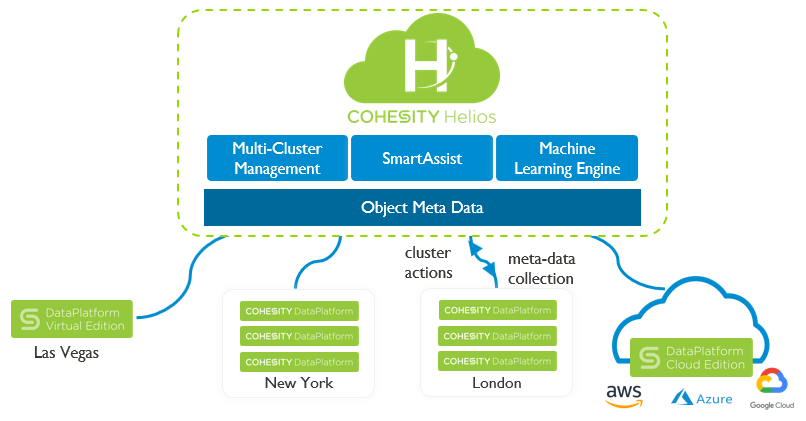Cohesity has started is journey focusing in the hyperconverged secondary storage area, but in the last two years, it has embraced the cloud power focusing more on the public and hybrid cloud integrations.
Now Cohesity has announced the release of Cohesity Helios, a SaaS-based management solution that empowers customers to see, manage, and take action on their secondary data and applications globally, from a single dashboard, while benefiting from powerful analytics and machine learning (ML) capabilities that generate valuable insights from untapped data.
Helios allows IT admins to control all their Cohesity clusters located on-prep, in the cloud or edge from a single dashboard. But it’s much more than a passive dashboard, Cohesity Helios utilizes cutting edge machine learning algorithms to proactively assess IT needs and automate infrastructure resources.

With Cohesity Helios will be possible:
- Accelerating IT Productivity – With Helios, enterprises have the ability to roll out policies or make upgrades across their entire Cohesity multi-cluster environment with a single click, drastically simplifying IT operations. Additional features make infrastructure management even more efficient:
- Access a smart assistant for IT: Administrators can define service-level agreements (SLAs) by job and workload and Cohesity SmartAssist will automatically evaluate required versus available resources (e.g., compute, storage) across all clusters to meet SLAs or suggest changes as needed.
- Utilise machine learning for operational insights: Helios evaluates how infrastructure is being used and utilizes ML to determine what adjustments or modifications may be necessary for the future. For example, based on current storage utilization and workload makeup, Helios will proactively recommend when additional resources might be needed to continue meeting business requirements.
- Benefit from peer comparisons: The SaaS solution not only evaluates customers’ operational metadata sets but also analyses operational metadata from Cohesity customers globally. Organisations can compare infrastructure utilization against anonymized benchmarks from their peers and uncover best practices.
This could be very interesting to understand how good is your implementation, but of course make some possible doubts on privacy of data.
- Simplifying Business Planning and Improving Continuity – Businesses cannot afford downtime, but the complexity of modern IT infrastructure makes it increasingly difficult to prevent. Through ML, Helios helps organisations improve business continuity across their secondary infrastructure. Helios empowers organisations to:
- Benefit from proactive health checks: Based on global operational metadata collected from Cohesity, Helios looks at the actions taken by an IT administrator across their sites and alerts them, for example, of anomalies that don’t follow best practices (e.g., if a financial services customer forget to turn on encryption). Helios will then suggest a recommended path forward.
- Relax with automation: Customers get peace of mind in knowing Helios can automate corrective action for failure of non-critical system resources, including proactively notifying the Cohesity global support team to ensure that any issue is quickly addressed.
- Access a “crystal ball”: Helios empowers administrators to test the impact of future changes across their clusters before rolling them out. Administrators can also evaluate alternative approaches with “what-if” analyses powered by machine learning.
- Maximizing Agility and Probing Untapped Data for Meaningful Insights – Helios provides customers with new levels of agility. Because customers can see all of their Cohesity sites in one view, organizations can easily move data from one location to another, maximizing capacity and improving disaster recovery while optimizing costs. Organisations can also use the Cohesity Analytics Workbench (AWB) to drive meaningful insights from untapped data, starting with three applications:
- Detect patterns that help ensure compliance: With the Pattern Finder application, enterprises can search their secondary data for strings of characters that match the pattern of sensitive or personal data, for example, a Social Security number or a phone number. Organisations can then take corrective action to comply with stringent regulatory requirements.
- Pinpoint bad passwords to mitigate risks: The smart Password Detection application gives companies a way to improve security by searching across global data sets to uncover passwords that fail to meet best practices, such as those that include personal or company names, or are stored in plain text.
- Transcode videos to optimize for capacity: To help optimize resources, IT admins — including those within the security, surveillance and healthcare industries — can use the Video Compression application to reduce the size of large media files while optimizing space.
For more information:
- Read Cohesity’s blog post, “Simplifying Global Secondary Data and Apps Management for Better Insights”
- Download the Cohesity Helios data sheet
- Watch a video on Cohesity Helios
- Read about Cohesity’s FY 2018 financial performance, customer growth and innovations in this press release












